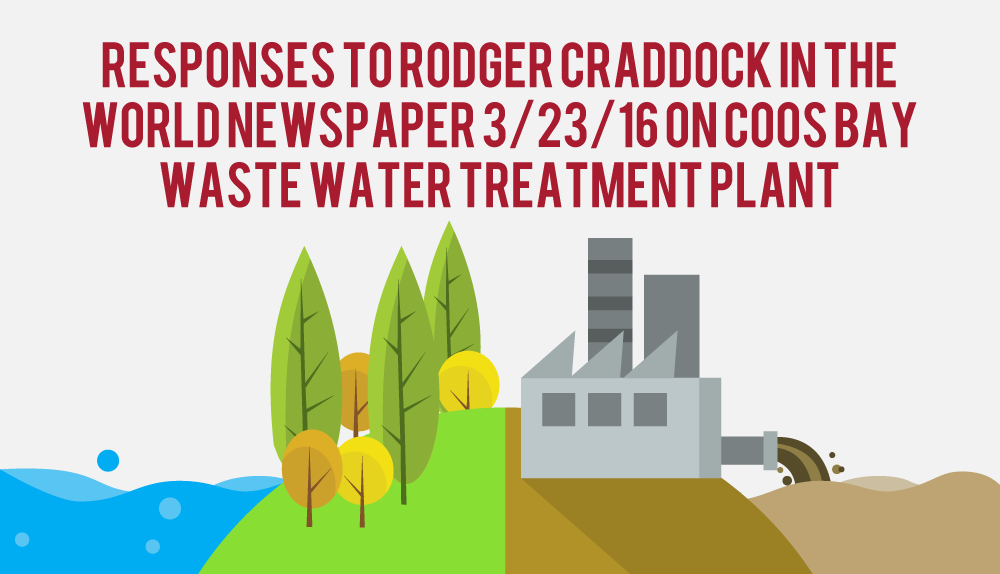DBWT has completed 6 feasibility studies, value engineering, and cost evaluations and arrived at a final design and proposal for a regional plant WWTP , using the world’s” best available technology” (BAT), and keeping sewer rates under 60$ thru 2041. The city has never evaluated our final proposal producing EPA Class A water for reuse. Coos Bay’s 2 WWTPs permits only require 85% removal of fecal solids and BOD (Biological Oxygen Demand), the rest goes into the Bay. If North Bend participated in the Regional plant the rates would be less than $50 per month for potentially the next 50 years. Mayor Shoji’s 2014 flyer projected over 6 years to 2020 at 6.5%, a residential rate of 84$/month (based upon $81M costs). Rates projected over a full 20 year lifecycle are $145. A councilman computed $196 by 2028 (actually thru 2034) when using the newest $120M cost estimates by staff. Staff indicated cost may be $160M.
DBWT’s regional plant proposal, drawings, costs, and environmental documents can be found at www.coosbaywastewater.com, along with complete rebuttals of city responses. DBW and DBWT capabilities can be viewed at dbwt.us. The Regional plant would be owned by cities participating. If the new CB2 plant in Empire is built, opportunity for a Regional Plant is gone.
Bay Pollution
- EPA currently provides fecal coliform as the measure of pollution called “impairment”. FDA (Federal Food and Drug) 16-day study of clean oysters placed at 6 different locations in Coos Bay shows Norovirus contamination as high as 200 times infectious doses. EPA working with FDA has presented future testing methods which will eliminate fecal coliform as a measurement of “impairment”. Oysters also contained up to 45 times more Noroviruses than fecal coliform. DEQ and City are using fecal coliform as a measure of health for marine life and citizens, and claim effluents are “cleaner” than the Bay.
- Clean oysters placed in Coos Bay at 6 different oyster growing areas for 16 days contained up to 200 times the infectious dose of Noroviruses. CDC (Centers for Disease Control) state Noroviruses contribute 90% of the infectious diseases in the U.S. Newport, Oregon oysters recently were found to have caused a Norovirus infectious outbreak.
- FDA traced hazardous and infectious human pathogens (viruses, bacteria) entering our human food chain and were tracked directly to the wastewater plant effluents. Under OAR rules this requires an EIS (Environmental Impact Study) which has never been done. FDA tested the shoreline around the bay for septic tank and other non-point source impacts and found their impacts were “minor.” Microbiologists from EPA, CDC, and FDA recognize the infectious health hazards from Coos Bay and North Bends effluents, even if the City of Coos Bay does not. The FDA study was given to us from the City of North Bend, which started us on this mission to clean up our bay for our children.
Cost Comparison
DBWT and DBW are Oregon Corporations and, for over 40 years, have engineered and bid hundreds of projects along with building many of them, we are also licensed Oregon General Contractors. Our budget estimates of cost are supported by this experience and the City does not have this combination of experience or qualifications. However, the City has a problem with the transparency of their costs and projections of ratepayer bills.
- City has been under an MAO from DEQ for both CB1 and CB2 since 2003 for “Bypassing“, spilling, and basically polluting the Bay.
- City has only completed value engineering on CB2 after 13 years (the smallest plant) for up to $30M and a cap of $35M.CB2 raw sludge with 3 pump stations is diverted to CB1 as also the costs.
- City claims $15M for CB1 upgrade. How much is for CB2 sludge digestion? City should present CB1 upgrade costs for the MAO.
- The total costs presented by staff to council for waste water was $40M in 2008, $81M in 2013, $120M in 2015, with the possibility of $160M. These are not total capital, interest, and OM costs thru the 20 year lifecycle of both CB1 and CB2. City should produce 20 year projected ratepayer cost as councilman Daily and DBWT have.
- DBWT has estimated full 20 year lifecycle costs for both CB1 and CB2 upgrades to meet MAOs. A Regional plant would replace both with newest technologies; lower O&M costs, and stop the endless cycle in Coos Bay of rebuilds and upgrades.
- The O&M costs presented by the City raise questions. An audit of the OMI and the city cost for all items of equipment replacement, biosolids handling, and additional staff will find our estimates closer to reality. If the City is only using OMI costs projected for 20 years, this is misleading.
- Regional Plan includes North Bend for total Capital and O&M for 20 years. If North Bend chooses not to participate, then 20 year lifecycle costs for the Regional plant will be lower and Coos Bay’s rates are reduced.
Coos Bay Waste Water Management
Why is Coos Bay continually upgrading, increasing rates, city manager salary, adding staff, dumping wastes into the bay, and North Bend is not? North Bend rates are about half, do not bypass waste, and have fewer customers and revenues. North Bends accounting, records, and management are very transparent, cooperative, and thinking forward. DBWT spent many hours and had to pay almost $1,000 to get data (incomplete) from Coos Bay staff. We spent zero for very complete data from North Bend. We asked many times for a meeting with staff and representatives from Coos Bay council and they refused. North Bend courtesy provided such meeting on first request which included the Mayor.
Dennis Beetham
CEO of DBW and DBWT

